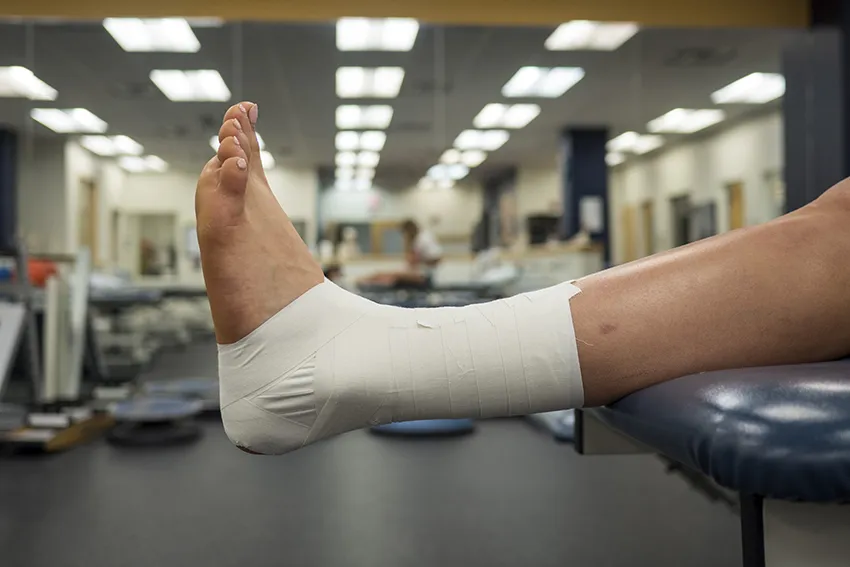
Sports Taping
The world of sports and fitness is a constantly evolving one. It seems that every week, athletes are trying something new to enhance their performance and preserve their body’s health. Even those who are simply looking to maintain their own personal fitness are trying new and trendy exercise preparation methods. One method that remains effective and has withstood the test of time is the use of athletic tape. From track stars and NBA players to those just beginning their fitness journey, the benefits of athletic tape can help any exerciser improve their workout and, more importantly, stay injury free. Here are some of the different types of athletic tape and how they might help you.
Preventing Injury
Traditional taping is one of the most common methods of preventing injury, especially among athletes. This is a method that involves using a more rigid athletic tape in an effort to keep muscles or bones in a certain position. This is especially used in areas of the body near joints, such as ankles, wrists, and hands. This added support can help prevent sprains, breaks, or other injuries that may occur from exercise and competitive sports.
Athletes also use less restrictive tape to help prevent injuries. Elastic therapeutic tape is one of the most popular types of athletic tape. Its popularity skyrocketed after the 2008 Beijing Olympics when most of the athletes were seen wearing the colorful material on their skin while competing. What makes this athletic tape important is that it is used during exercise preparation in an effort to slightly lift the skin, leaving enough room between the skin and muscles to increase blood flow and lymphatic drainage. Essentially, the increased flow can help prevent muscle cramps, spasms, and other common athletic injuries. Athletic tape is also unique in that it does not restrict the range of motion, allowing athletes to maintain their flexibility and comfort while exercising or competing. In fact, this athletic tape has been known to increase the range of motion for athletes since it reduces inflammation. If you’re somebody who suffers from chronic muscle fatigue or cramps, the athletic tape could be the key to alleviate this during your workouts. Though useful, elastic therapeutic tape should always be applied by a certified athletic training professional to prevent injury and increase effectiveness.
Rehabilitation
Though athletic tape can help prevent injuries caused by exercise, injuries can, unfortunately, still occur. When they do, athletic tape can be the effective remedy you need. The use of traditional athletic tape in limiting the range of motion for certain muscles and joints can help the body heal faster versus if the movement was not restricted. It can also serve as a splint for sprained joints, which helps the injury heal at a much faster rate as well. By compressing the muscle, traditional athletic tape can help decrease swelling, which can alleviate pain and prevent further injury.
Elastic therapeutic tape is used for the same reasons but in different ways. By helping to increase blood flow in the injured area, athletic tape decreases swelling which alleviates pain. The elasticity of the athletic tape can also serve as support for the affected muscles. It naturally goes back to its original position, which takes some of the workload off of the athlete’s muscle. When the athlete is well enough to return to their sport or activity, the tape can help support the previously affected area from re-injury and keep any pain at bay. Athletic tape can also help correct any form issues that may stem from injury or preexisting conditions. A trainer can perform a runner’s analysis to apply the tape in an optimal position for their injury, helping fix their form and prevent further harm.
Chronic Issues
Though athletic tape is often associated with fitness and athletes, it can also be used to help treat certain issues of chronic pain that people may suffer from. Athletic tape, specifically elastic therapeutic tape, has been used to relieve discomfort caused by chronic pain. Rather than resort to surgery or painkillers, athletic tape has been known to decrease some of the pain caused by this common ailment for more than 100 million people. Using athletic tape on the back and neck has also been used to alleviate headaches and migraines. By helping improve a person’s posture and allowing easier blood flow in the neck and back, wearers of athletic tape have reported less frequent headaches and a decreased severity in their migraines. It can also be used to help with other conditions such as carpal tunnel and tendonitis, which goes to show that you do not necessarily need to be an athlete to appreciate the importance, usefulness and capabilities of athletic tape.
